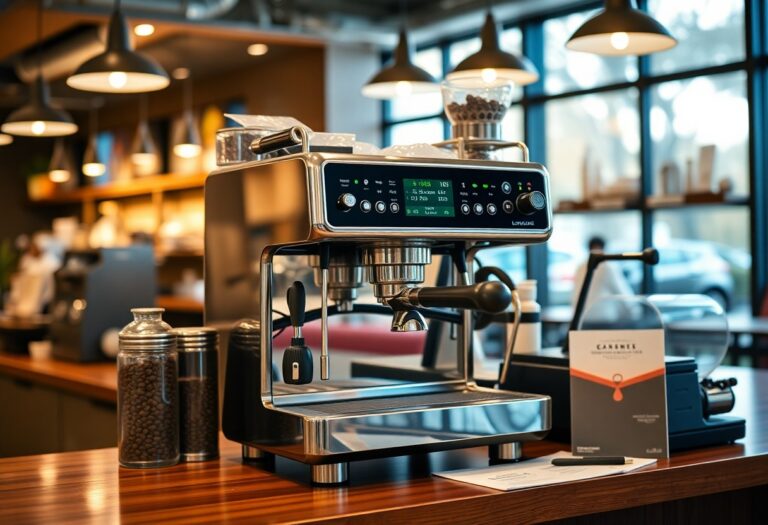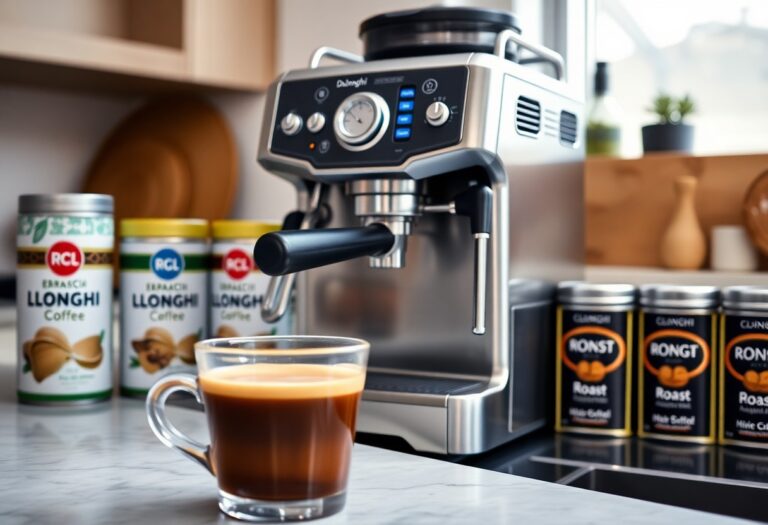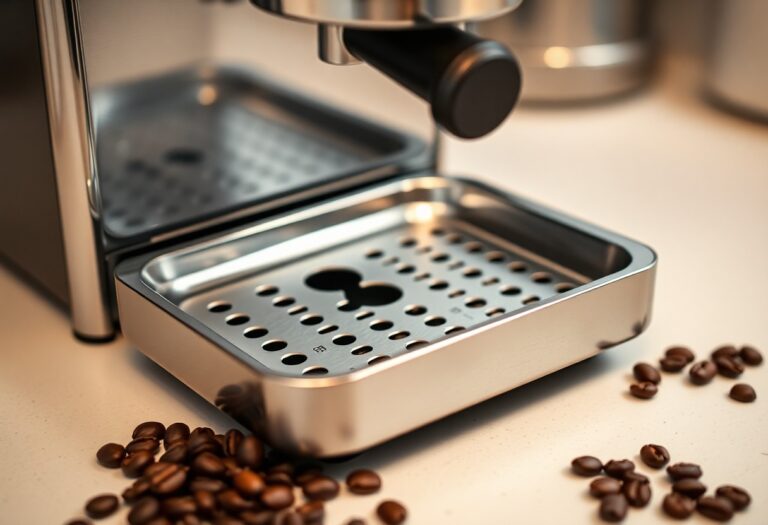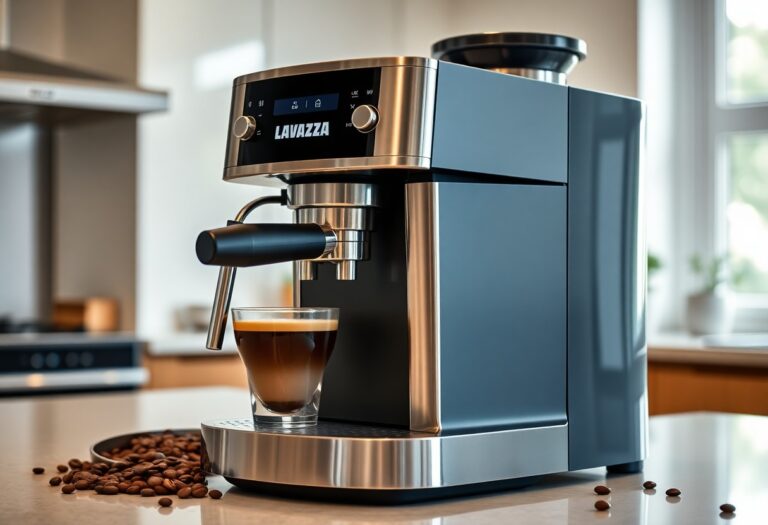What Coffee is Used for an Espresso Machine – Espresso Beans
Beans are the heart of your espresso machine, and selecting the right espresso beans can greatly affect the quality of your brew. You should look for high-quality, freshly roasted beans specifically labeled for espresso, typically featuring a dark roast. These beans offer a rich, bold flavor and the necessary oils to create that coveted creamy crema on top of your shot. Understanding the difference in bean origin and blend will enable you to tailor your espresso experience, ensuring the perfect balance of taste and aroma for your coffee journey.
Key Takeaways:
- Espresso beans are typically a blend of Arabica and Robusta varieties, each contributing to flavor and crema.
- Freshly roasted coffee beans are ideal for espresso as they ensure optimal flavor and aroma.
- Coarse grinding is necessary when preparing espresso, allowing for a quick extraction process in the brewing cycle.
- Single-origin beans can provide unique flavors, but blends are commonly preferred for a balanced espresso profile.
- Storing espresso beans in a cool, dark place helps maintain their freshness and flavor integrity over time.
The Magic of Espresso Beans: What Makes Them Unique
Espresso beans are not just any coffee beans; they possess unique qualities that contribute to the intense flavor and aroma of your espresso. These beans are specifically chosen and processed to create a concentrated shot of coffee that delivers bold tastes and rich crema. The meticulous selection of coffee varieties along with the perfect preparation technique transforms these beans into what many consider the heart of a good espresso. Observing their journey from bean to cup reveals just how special espresso beans truly are.
The Bean’s Origin: Arabica vs. Robusta
When dicking out espresso beans, you’re faced with two primary types: Arabica and Robusta. Arabica beans are celebrated for their smooth, nuanced flavors and lower caffeine content, making them the preferred choice among connoisseurs. In contrast, Robusta beans are known for their strong, earthy taste and higher caffeine levels, often providing a fuller body and pronounced bitterness. Understanding the differences between these beans can profoundly affect your espresso’s flavor profile and overall experience.
The Role of Roasting in Espresso Quality
Roasting is an art that directly influences the quality of your espresso. It transforms raw coffee beans into the aromatic, flavorful morsels you crave, unlocking necessary oils and compounds. The roast level—whether light, medium, or dark—determines the balance of acidity, sweetness, and bitterness in your cup. A light roast preserves more of the bean’s original character, while a dark roast imparts a bolder flavor and a rich, chocolatey finish. Each roasting technique impacts the final taste, making it necessary for you to choose beans that have been expertly roasted to suit your palate.
Notably, the roasting process also develops caramelization and Maillard reaction flavors, which create complexity in your espresso. Lighter roasts will exhibit fruity and floral notes, while darker roasts may introduce nutty or smoky flavors. Additionally, the roast time and temperature influence the beans’ oil saturation, contributing to the coveted crema. Choosing beans with the appropriate roast profile for your machine, along with considering your taste preferences, is vital to achieving a well-rounded and delightful espresso experience.

Grind Size Matters: The Key to Perfect Espresso
The grind size of your coffee directly influences the extraction process and, ultimately, the flavor of your espresso. A finer grind increases the surface area, allowing for a faster extraction, while a coarser grind results in slower extraction and different flavor profiles. Striking the right balance is necessary: too fine, and you risk over-extraction and bitterness; too coarse, and under-extraction leads to sour or watery coffee. Aim for a consistency that works harmoniously with your machine to achieve that rich, creamy crema you desire.
The Importance of Consistency in Grind
Consistency in grind size enhances not only the taste but also the overall experience of your espresso. A uniform grind ensures that all coffee particles undergo the same extraction rate, leading to a balanced flavor profile. If your grind is uneven, some particles will be over-extracted while others will be under-extracted, resulting in a muddled and unsatisfactory cup. Investing in a good grinder that offers precision and consistency will elevate your espresso game significantly.
Choosing the Right Grind for Your Espresso Machine
Your espresso machine may require specific grind sizes to function optimally, and understanding this helps you make informed choices. Most machines perform best with a fine to medium-fine grind, but the ideal setting can vary based on the type and brand of your machine. For instance, a manual espresso machine might need a more precise grind compared to an automatic machine, which often has built-in grinders. Conducting taste tests and making minor adjustments can lead you to the perfect grind size tailored for your specific setup.
To further refine your espresso, take into account factors like the pressure of your machine and the type of beans you’re using, as both influence the grind size. A pressure-based machine that brews at 9 bars generally extracts best with a fine grind level, while other machines might thrive on something slightly coarser. Track your results with different grind settings and adjust the size until you find that sweet spot in taste and aroma. Personalize your approach based on your espresso machine and preferred flavor notes for a consistently rich brew.
Beyond Beans: The Impact of Freshness on Flavor
Freshness plays a pivotal role in the flavor profile of your espresso. As time passes after roasting, beans begin to lose their necessary oils and volatile compounds, leading to diminished taste and aroma. The fruits of your labor in the espresso machine won’t translate to a rich, full-bodied shot if the beans aren’t fresh. Emphasizing the importance of using fresh espresso beans helps you achieve that coveted, robust flavor in your cup.
How Staleness Affects Your Brew
Stale beans can ruin your espresso experience, imparting a flat, lifeless taste. As beans age, they lose the vibrant flavors that you desire, and over-extraction can become a risk, producing bitter notes. This lack of freshness often leads to a more astringent brew, meaning that your efforts might yield disappointing results. For optimal flavor, using freshly roasted beans is always best.
Tips for Storing Espresso Beans Properly
To maintain the freshness of your espresso beans, proper storage is necessary. Keep them in an airtight container, away from light, heat, and moisture. A dark, cool pantry or cupboard is ideal, as it shields them from damaging environmental factors. Use only what you need and try to consume the beans within a few weeks of roasting for the best flavor. Properly stored beans can enhance your espresso shots significantly. Any poor storage practices can lead to unwanted staleness.
- Airtight container
- Cooled environment
- Consuming within weeks
- Exposure to light
- Humidity control
Using the right storage techniques for your espresso beans can be the difference between an invigorating shot and a dull cup. Always opt for an opaque container to block out light and consider carbon dioxide valves for newly roasted beans to maintain freshness without venting harmful gasses. The right temperature is just as vital; avoid placing the beans near the stove or refrigerator. Any simple oversight in these storage practices can impact the quality of your brew.
- Opaque container
- Carbon dioxide valves
- Avoid heat sources
- Room temperature
- Regularly check freshness
Crafting Your Perfect Brew: Customizing Your Espresso Experience
Personalizing your espresso experience is all about experimenting with various factors, including grind size, brewing time, and coffee origin. Adjusting these elements allows you to fine-tune the flavor and strength of your brew, aligning it with your specific taste preferences. You might ask yourself, when someone buys an espresso machine, do they just use regular coffee grounds in it? The answer lies in understanding the nuances that can elevate your coffee-making journey.
Exploring Flavor Profiles: Sweet, Bitter, and Balanced
Delving into various flavor profiles will enhance your espresso experience. You can aim for sweetness to balance bitterness, creating a harmonious cup. Selecting the right bean variety and roast level plays a pivotal role in this, as different beans naturally exhibit varying flavor characteristics. The final taste will be a reflection of your choices, so take the time to explore and find your ideal blend.
The Role of Water Quality in Espresso Extraction
The composition of your water significantly affects espresso extraction. High-quality water with balanced mineral content enhances the extraction process, facilitating the release of oils and flavors from the coffee grounds. Aiming for water that is neither too soft nor too hard can ensure that your espresso has the depth and complexity you’re seeking. Too many impurities can lead to off-flavors while inadequate mineral content might hinder extraction.
In practical terms, you want water that contains around 150-200 mg/L of total dissolved solids (TDS) and a balanced ratio of magnesium and calcium. This can make all the difference in achieving a rich, velvety crema on your espresso. Utilizing filtered or bottled water may often be beneficial, as it eliminates the chlorine and contaminants commonly found in tap water. Consistency is key; maintaining the same standard for water quality ensures that you can replicate that perfect cup every time.
Common Missteps in Selecting Espresso Beans
Many enthusiasts stumble when choosing espresso beans, often opting for what is trendy rather than what suits their taste. A common error is assuming all coffee labeled as espresso is suitable for machines; this isn’t the case. You can read more about this in our feature on What Coffee To Use For Espresso Machines. Preference varies widely, so understanding your unique palate can lead to better selections and superior shots.
How to Avoid the Pitfalls of Bean Variability
To make consistently great espresso, select beans that have minimal variability in flavor and quality. Sourcing from reputable roasters that provide detailed tasting notes can greatly reduce the chances of encountering beans that differ wildly from batch to batch. Always check roast dates and aim for blends known for their stability across different harvests.
Debunking Myths Surrounding Espresso Beans
Numerous misconceptions about espresso beans can misguide your purchasing decisions. One prevalent myth is that the darker the roast, the better it is for espresso. This isn’t necessarily true, as many lighter roasted beans can also produce rich, flavorful shots. Understanding the roast profile and its impact on flavor can enhance your espresso experience.
Some believe that espresso must come exclusively from Arabica beans. While Arabica is often the gold standard, blends containing Robusta can add depth and caffeine kick, enhancing crema and overall richness. Additionally, many think espresso is just a method of brewing, but it’s the unique combination of grind, pressure, and extraction time that simultaneously defines what espresso can be. To make informed choices, focus on quality, freshness, and what meets your taste criteria rather than adhering to generalized beliefs.
Summing up
Upon reflecting, you should understand that selecting the right coffee for your espresso machine is crucial for achieving that rich, robust flavor. Espresso beans are specifically processed and roasted to produce a concentrated shot that highlights the unique characteristics of the bean. By choosing high-quality espresso beans, you can elevate your coffee experience at home, ensuring that each cup delivers the bold, smooth taste you desire. Consider experimenting with different blends and roast levels to find your perfect match for your espresso creations.
FAQ
Q: What type of beans is best for an espresso machine?
A: The best type of beans for an espresso machine are those specifically labeled as espresso beans. These beans are typically a blend of arabica and robusta beans, which provide a rich flavor, body, and crema. While you can technically use any coffee bean, espresso blends are especially roasted to create a smooth, concentrated shot, making them ideal for brewing espresso.
Q: How are espresso beans different from regular coffee beans?
A: Espresso beans are often roasted darker than regular coffee beans, which enhances the flavors and oils that contribute to espresso’s signature richness. Additionally, the grind size for espresso is much finer than that for other brewing methods, allowing water to extract flavors quickly during the short brewing time. Regular coffee is typically ground coarser since it is brewed using different methods like drip or French press.
Q: Can I use flavored coffee for espresso?
A: Yes, you can use flavored coffee for espresso. However, it’s important to note that flavored coffees are often made from lower quality beans and the added flavoring can sometimes interfere with the espresso’s natural flavor profile. If you enjoy flavored espresso, consider higher-quality beans that have been naturally flavored or infused, ensuring a better balance of taste.
Q: What grind size should I use for espresso beans?
A: The grind size for espresso should be very fine, resembling table salt. This fine grind allows for optimal extraction during the short brewing time of 25-30 seconds. If the grind is too coarse, you may end up with sour or weak espresso; if too fine, it can lead to a bitter taste due to over-extraction. Experimenting with grind size is imperative to find the perfect balance for your specific espresso machine.
Q: How fresh should espresso beans be for optimal use?
A: For the best flavor and aroma, espresso beans should be freshly roasted and used within two to four weeks after roasting. Coffee beans begin to lose their freshness quickly after roasting due to exposure to air, light, and moisture. For maximum flavor, store beans in an airtight container in a cool and dark place. Grinding the beans just before brewing will also enhance the overall quality of your espresso.







